Bosch DWW06W851A, DWW06W450A, DWW09W851A, DWW09W651A, HLS79R350ADWW06W450A User Manual
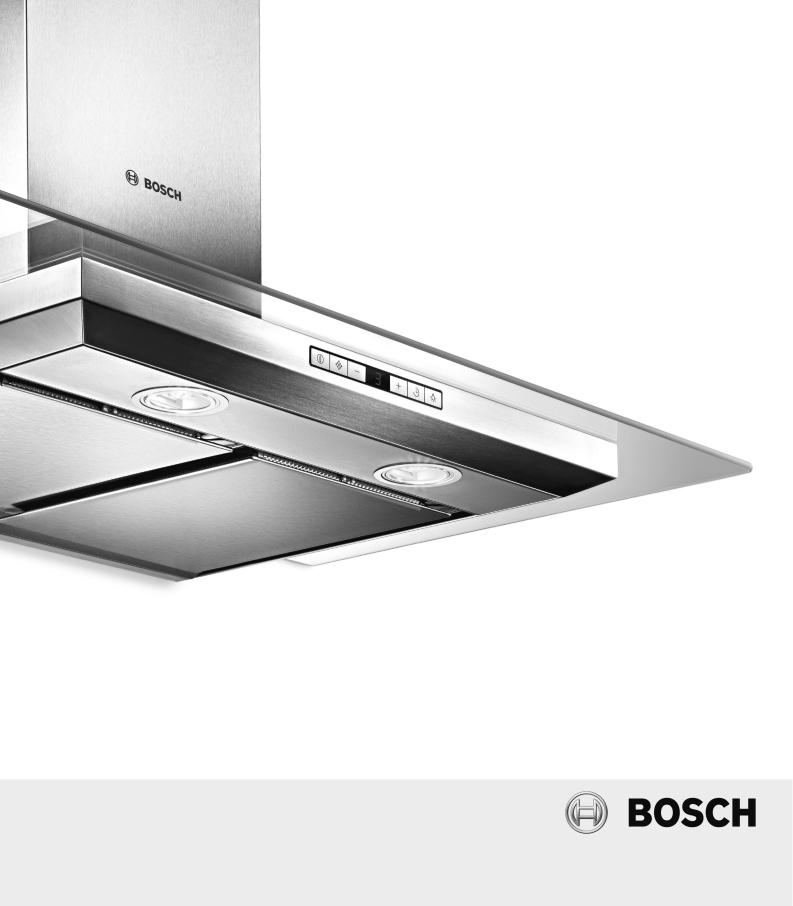
Extractor hood
[en] Instructions for installation and use
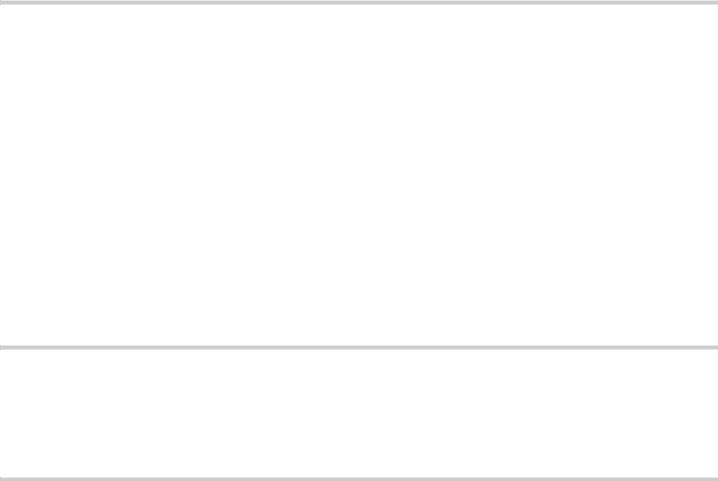
Ú Table of contents |
|
INSTRUCTION MANUAL............................................................ |
2 |
Important safety information................................................ |
2 |
Environmental protection..................................................... |
4 |
Environmentally-friendly disposal................................................ |
4 |
Operating modes................................................................... |
4 |
Exhaust air mode........................................................................... |
4 |
Circulating-air mode ...................................................................... |
4 |
Operating the appliance ....................................................... |
5 |
Lighting ............................................................................................ |
5 |
Cleaning and maintenance................................................... |
5 |
Trouble shooting ................................................................... |
7 |
After-sales service ................................................................ |
8 |
Accessories for circulating-air mode.......................................... |
8 |
INSTALLATION INSTRUCTIONS............................................... |
9 |
Important safety information................................................ |
9 |
General information ............................................................ |
11 |
Exhaust air mode........................................................................ |
11 |
Exhaust duct ................................................................................ |
11 |
Checking the wall ....................................................................... |
11 |
Electrical connection .................................................................. |
11 |
Installation ........................................................................... |
12 |
Preparing for installation............................................................ |
12 |
Installation .................................................................................... |
12 |
Finishing installation of the appliance..................................... |
13 |
Connecting the appliance to the power supply .................... |
13 |
Attaching the flue duct............................................................... |
13 |
INSTRUCTION MANUAL
Additional information on products, accessories, replacement parts and services can be found at www.bosch-home.com and in the online shop www.bosch-eshop.com
:Important safety information
Read these instructions carefully. Only then will you be able to operate your appliance safely and correctly. Retain the instruction manual and installation instructions for future use or for subsequent owners.
The appliance can only be used safely if it is correctly installed according to the safety instructions. The installer is responsible for ensuring that the appliance works perfectly at its installation location.
This appliance is intended for domestic use and the household environment only. The appliance is not intended for use outside. Do not leave the appliance unattended during operation. The manufacturer is not liable for damage which is caused by improper use or incorrect operation.
This appliance may be used by children over the age of 8 years old and by persons with reduced physical, sensory or mental capabilities or by persons with a lack of experience or knowledge if they are supervised or are instructed by a person responsible for their safety how to use the appliance safely and have understood the associated hazards.
Children must not play with, on, or around the appliance. Children must not clean the appliance or carry out general maintenance unless they are at least 8 years old and are being supervised.
Keep children below the age of 8 years old at a safe distance from the appliance and power cable.
Check the appliance for damage after unpacking it. Do not connect the appliance if it has been damaged in transport.
This appliance is not intended for operation with an external clock timer or a remote control.
Danger of suffocation!
Packaging material is dangerous to children. Never allow children to play with packaging material.
Danger of death!
Risk of poisoning from flue gases that are drawn back in.
Always ensure adequate fresh air in the room if the appliance is being operated in exhaust air mode at the same time as room air-dependent heat-producing appliance is being operated.
2
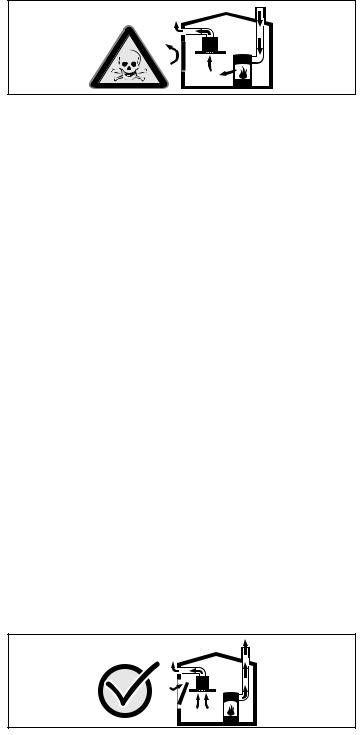
Room air-dependent heat-producing appliances (e.g. gas, oil, wood or coaloperated heaters, continuous flow heaters or water heaters) obtain combustion air from the room in which they are installed and discharge the exhaust gases into the open air through an exhaust gas system (e.g. a chimney).
In combination with an activated vapour extractor hood, room air is extracted from the kitchen and neighbouring rooms - a partial vacuum is produced if not enough fresh air is supplied. Toxic gases from the chimney or the extraction shaft are sucked back into the living space.
■Adequate incoming air must therefore always be ensured.
■An incoming/exhaust air wall box alone will not ensure compliance with the limit.
Safe operation is possible only when the partial vacuum in the place where the heatproducing appliance is installed does not exceed 4 Pa (0.04 mbar). This can be achieved when the air needed for combustion is able to enter through openings that cannot be sealed, for example in doors, windows, incoming/ exhaust air wall boxes or by other technical means.
In any case, consult your responsible Master Chimney Sweep. He is able to assess the house's entire ventilation setup and will suggest the suitable ventilation measures to you.
Unrestricted operation is possible if the vapour extractor hood is operated exclusively in the circulating-air mode.
Risk of fire!
■Grease deposits in the grease filter may catch fire.
Clean the grease filter at least every 2 months.
Never operate the appliance without the grease filter.
■Grease deposits in the grease filter may catch fire. Never work with naked flames close to the appliance (e.g. flambéing). Do not install the appliance near a heatproducing appliance for solid fuel (e.g. wood or coal) unless a closed, nonremovable cover is available. There must be no flying sparks.
■Hot oil and fat can ignite very quickly. Never leave hot fat or oil unattended. Never use water to put out burning oil or fat. Switch off the hotplate. Extinguish flames carefully using a lid, fire blanket or something similar.
■When gas burners are in operation without any cookware placed on them, they can build up a lot of heat. A ventilation appliance installed above the cooker may become damaged or catch fire. Only operate the gas burners with cookware on them.
■Operating several gas burners at the same time gives rise to a great deal of heat. A ventilation appliance installed above the cooker may become damaged or catch fire. Never operate two gas burners simultaneously on the highest flame for longer than 15 minutes. One large burner of more than 5 kW (wok) is equivalent to the power of two gas burners.
Risk of burns!
The accessible parts become very hot when in operation. Never touch hot parts. Keep children at a safe distance.
Risk of injury!
■Components inside the appliance may have sharp edges. Wear protective gloves.
■Items placed on the appliance may fall down. Do not place any objects on the appliance.
3
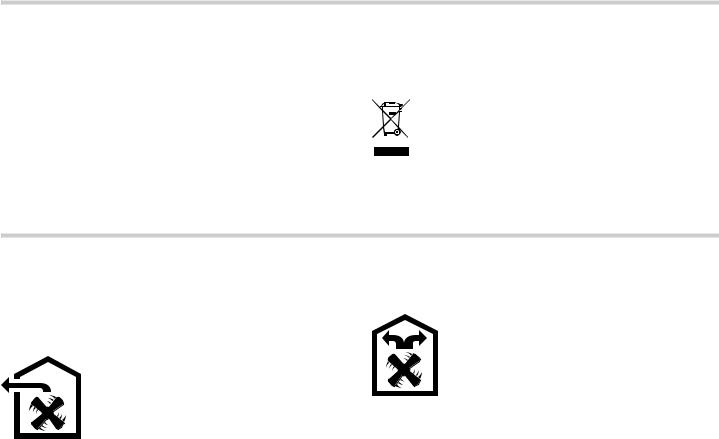
Risk of electric shock!
■A defective appliance may cause electric shock. Never switch on a defective appliance. Unplug the appliance from the mains or switch off the circuit breaker in the fuse box. Contact the after-sales service.
■Incorrect repairs are dangerous. Repairs may only be carried out and damaged power cables replaced by one of our trained after-sales technicians. If the appliance is defective, unplug the appliance from the mains or switch off the circuit breaker in the fuse box. Contact the after-sales service.
■Do not use any high-pressure cleaners or steam cleaners, which can result in an electric shock.
Causes of damage
Caution!
Risk of damage due to corrosion. Always switch on the appliance while cooking to avoid condensation. Condensate can produce corrosion damage.
Always replace faulty bulbs to prevent the remaining bulbs from overloading.
Risk of damage due to ingress of humidity into the electronic circuitry. Never clean operator controls with a wet cloth.
Surface damage due to incorrect cleaning. Clean stainless steel surfaces in the direction of the grain only. Do not use any stainless steel cleaners for operator controls.
Surface damage due to strong or abrasive cleaning agents. Never use strong and abrasive cleaning agents.
Risk of damage from returning condensate. Install the exhaust duct in such a way that it falls away from the appliance slightly (1° slope).
Environmental protection
Unpack the appliance and dispose of the packaging in an environmentally-responsible manner.
Environmentally-friendly disposal
Dispose of packaging in an environmentally-friendly manner.
This appliance is labelled in accordance with European Directive 2012/19/EU concerning used electrical and electronic appliances (waste electrical and electronic equipment - WEEE). The guideline determines the framework for the return and recycling of used appliances as applicable throughout the EU.
Operating modes
This appliance can be used in exhaust-air mode or circulatingair mode.
Exhaust air mode
The air which is drawn in is cleaned by the grease filters and conveyed to the exterior by a pipe system.
Note: The exhaust air must not be conveyed into a functioning smoke or exhaust gas flue or into a shaft which is used to ventilate installation rooms which contain heat-producing appliances.
■Before conveying the exhaust air into a non-functioning smoke or exhaust gas flue, obtain the consent of the heating engineer responsible.
■If the exhaust air is conveyed through the outer wall, a telescopic wall box should be used.
Circulating-air mode
The air which is drawn in is cleaned by the grease filters and an activated carbon filter and conveyed back into the kitchen.
Note: To bind odours in circulating-air mode, you must install an activated carbon filter. The different options for operating the appliance in circulating-air mode can be found in the brochure. Alternatively, ask your dealer. The required accessories are available from specialist outlets, from customer service or from the Online Shop. The accessory numbers can be found at the end of the instructions for use.
4
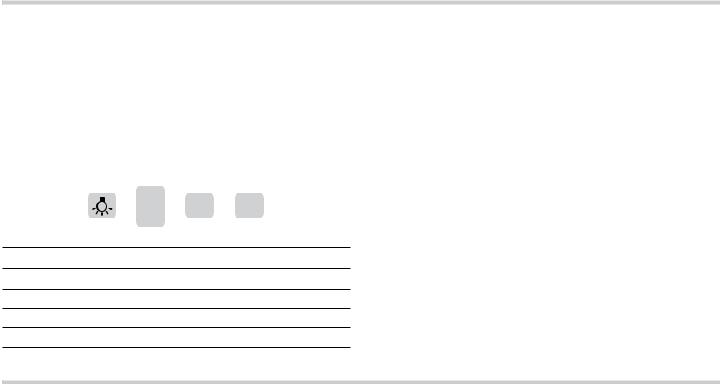
Operating the appliance
These instructions apply to several appliance variants. It is possible that individual features are described which do not apply to your appliance.
Note: Switch on the extractor hood when you start cooking and switch it off again several minutes after you have finished cooking. This is the most effective way of removing the kitchen fumes.
Setting the fan
Switching on
Press button 1, 2 or 3.
Switching off
Press the 0 button.
Control panel |
|
|
Lighting |
|
|
|
|
The lighting can be switched on and off independently of the |
|
|
|
|
||
|
|
ventilation. |
||
|
Press the A button. |
|||
|
|
|||
|
|
|
|
Explanation
ALight On/Off
0.1 Fan Off/Fan speed 1
2Fan speed 2
3Fan speed 3
Cleaning and maintenance
:Risk of burns!
The appliance will become hot during operation, especially near the bulbs. Allow the appliance to cool down before cleaning.
:Risk of electric shock!
Penetrating moisture may result in an electric shock. Clean the appliance using a damp cloth only. Before cleaning, pull out the mains plug or switch off the circuit breaker in the fuse box.
:Risk of electric shock!
Do not use any high-pressure cleaners or steam cleaners, which can result in an electric shock.
:Risk of injury!
Components inside the appliance may have sharp edges. Wear protective gloves.
Cleaning agents
Observe the information in the table to ensure that the different surfaces are not damaged by using the wrong type of cleaning agent. Do not use
■harsh or abrasive cleaning agents,
■cleaning agents with a high concentration of alcohol,
■hard scouring pads or sponges,
■high-pressure cleaners or steam cleaners.
Wash new sponge cloths thoroughly before use.
Follow all instructions and warnings included with the cleaning agents.
Area |
Cleaning agents |
|
|
Stainless steel |
Hot soapy water: |
|
Clean with a dish cloth and dry with a |
|
soft cloth. |
|
Clean stainless steel surfaces in the |
|
direction of the grain only. |
|
Special stainless steel cleaning prod- |
|
ucts are available from our after-sales |
|
service or from specialist retailers. |
|
Apply a very thin layer of the cleaning |
|
product with a soft cloth. |
|
|
Painted surfaces |
Hot soapy water: |
|
Clean using a damp dish cloth and |
|
dry with a soft cloth/towel. |
|
Do not use any stainless steel clean- |
|
ers. |
|
|
Aluminium and |
Glass cleaner: |
plastic |
Clean with a soft cloth. |
|
|
Glass |
Glass cleaner: |
|
Clean with a soft cloth. Do not use a |
|
glass scraper. |
|
|
Operating controls |
Hot soapy water: |
|
Clean using a damp dish cloth and |
|
dry with a soft cloth. |
|
Risk of damage to the electronics |
|
from penetrating moisture. Never |
|
clean operator controls with a wet |
|
cloth. |
|
Do not use any stainless steel clean- |
|
ers. |
|
|
5
